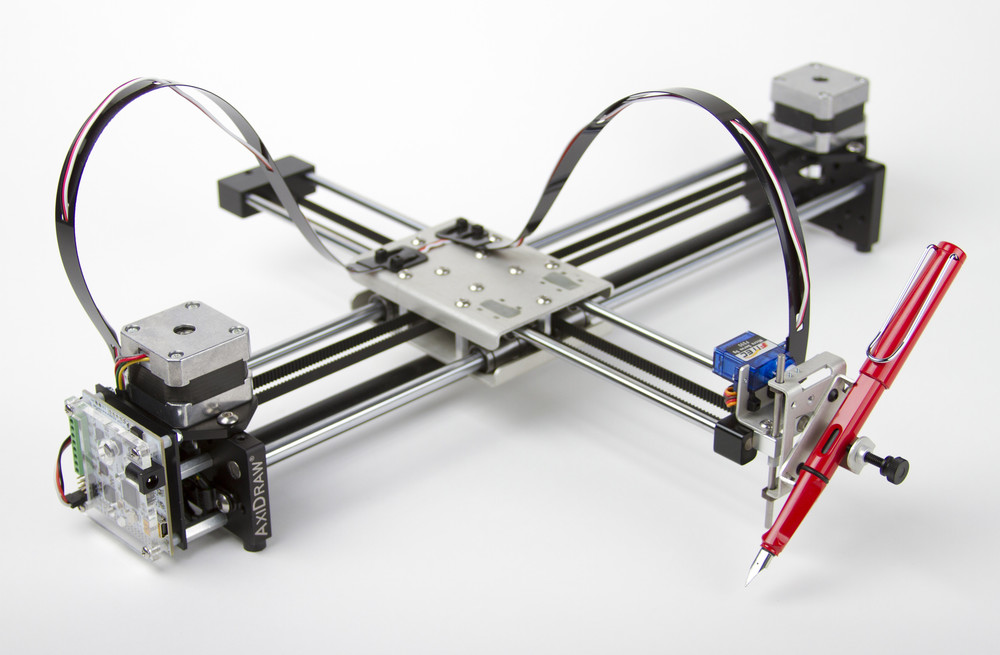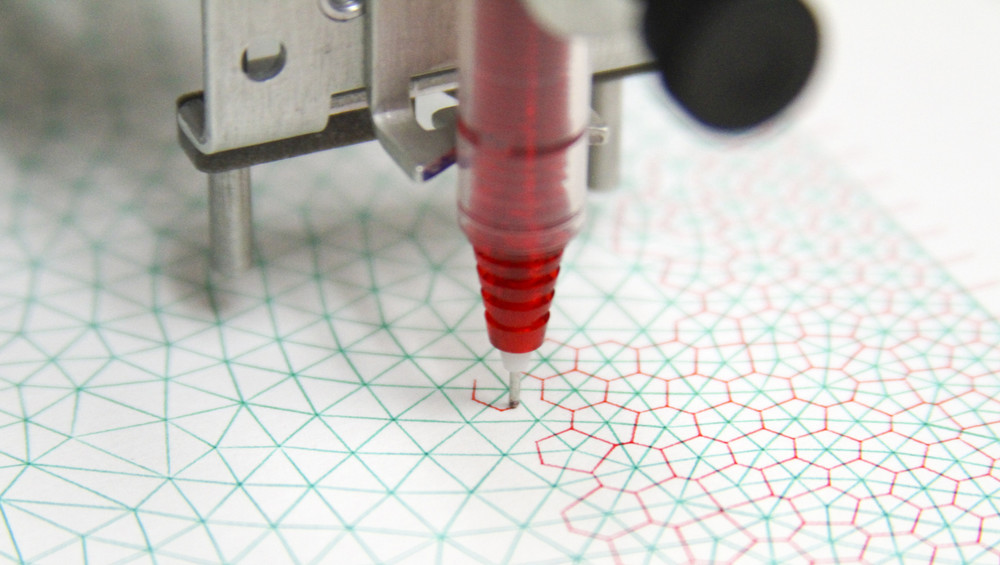- A tour of the MegaProcessor (YouTube)
- Inside the tiny RFID chip that runs San Francisco’s “Bay to Breakers” race
- Inkscape extension: Trace along centerlines
- A 3D-printed light-based zoetrope
- Dinosaur-era feathers, preserved in amber.
- Feynman diagram sculptures by Edward Tufte
- Schematics and manuals for the 1979 Asteroids video game cabinet
- Fliers for a Father’s Day Sale, from Obvious Plant.
- Dashcam footage: Driving Around San Francisco in 1953 (YouTube)
- NASA’s Juno mission to Jupiter: Orbit insertion as a dramatic movie trailer.
All posts by Windell Oskay
Ten Years of Evil Mad Scientist Laboratories
 Ten years ago today, Evil Mad Scientist Laboratories went live. Happy birthday to us!
Ten years ago today, Evil Mad Scientist Laboratories went live. Happy birthday to us!
We started Evil Mad Scientist way back in 2006 as a blog to help us document and organize our various hobby projects. Since then our projects have been featured in print magazines, in books, on television, in newspapers, at the White House, at museums, and on thousands of other blogs. We’ve built many friendships and many wonderful and bizarre machines, resurrected old computers and video games, and spent a lot of time playing with food, from 3D printing to fractal foods and on and on and on and on. We’ve published a book, released software, and published designs for physical things that people can make into their own. And of course, it all stopped being just a hobby about halfway through the decade.
As the years have passed, our projects have gradually gotten bigger— from a project every Wednesday (originally) to fewer but much more complex, multi-year projects. Along with big projects like the book and the 6502, we’re designing and producing families of soldering kits and art robots like the EggBot, WaterColorBot, and the new AxiDraw, which all bring joy to so many people.
What does the next decade have in store for us? Who knows! But we’re certainly looking forward to seeing what wonders it will bring.
To celebrate the anniversary, we are hosting an open house on July 21 at our shop in Sunnyvale, California, from 5-9 PM. Please come join us!
To all of you: Thanks for being such a great community, thanks for reading Evil Mad Scientist, and thanks for your continued support in all of our endeavors.
– Lenore & Windell
Linkdump: May 2016
- Mars is currently making its closest approach to Earth.
Here are some viewing tips. - Mining platinum from the roadside (YouTube)
- Crowdfunding a book about The Secret History of Mac Gaming
- How it’s made: “Long Eggs” (YouTube, german language)
- The Cattle Prod Selfie Stick
- Cute japanese bags, modeled on deep sea creatures
- Radio Shack to return once more?
- Converting stepper motors into industrial servo motors
- Camera tests for the Muppet Movie in 1979 (YouTube)
TABIYSL: Talk and demo at Maker Faire

I’ll be giving a talk and demo on Saturday at this year’s Maker Faire in San Mateo, CA. I’ll be demonstrating one of the many projects from my book, The Annotated Build-It-Yourself Science Laboratory (and signing books as well).
You can catch the talk and demo on Saturday, May 21, at 1:30 PM, on the Maker Show & Tell Stage.
The Annotated Build-It-Yourself Science Laboratory is available from Amazon.com, O’Reilly, and other sellers of books, as well as from our store.
Introducing the MOnSter 6502
Our collaborator Eric Schlaepfer has been extremely hard at work this year, designing a truly monstrous follow up to our giant-scale dis-integrated 555 and 741 circuits. This is the MOnSter 6502: a transistor-scale replica of the famous MOS 6502 microprocessor, the processor found at the heart of influential early computer systems such as the Apple ][ and the Commodore PET.
It is huge, at 12 × 15 inches, with over 4000 surface mount components, and 167 indicator LEDs added throughout so that you can see the flow of data.
This is a new project, still underway. We will be showing off the first prototype of the MOnSter 6502 at the Bay Area Maker Faire this coming weekend. We don’t promise that it will be completely working by then — this is a first stab at an extremely ambitious project — but we’re genuinely excited to show it off in this early stage.
You can read more about the MOnSter 6502 on its main project page, monster6502.com, and at Eric’s blog, tubetime.us.
(Before you ask, the MOnSter 6502 is not yet a kit or product that we’re selling. Right now, it’s an amazing thing that we’re trying to build. If you would like to stay in the loop as this project evolves, we’ve set up a special mailing list for updates.)
Introducing the AxiDraw
We are very pleased to introduce our newest art robot: the AxiDraw.
The AxiDraw is a simple, modern, precise, and versatile pen plotter, capable of writing or drawing on almost any flat surface. It can write with your favorite fountain pens, permanent markers, and other writing implements to handle an endless variety of applications. Its unique design features a writing head that extends beyond the machine, making it possible to draw on objects bigger than the machine itself.
The AxiDraw is a fantastic machine for making art — along with all those other things that you might use a pen-wielding robot for: Making “hand written” invitations, signing forms, or making neater whiteboard art than one might otherwise be able to.
AxiDraw is available to order today, and begins shipping next week. See it in action and learn more on the product page.
Linkdump: February 2016
- Voice recognition + Smith-Corona typewriter + servo motors: A retro-futuristic dictation machine.
- Spinning clay, from the perspective of the pottery wheel
- The fastest manmade object (ignoring our fastest space probes)? Possibly a nuclear-powered manhole cover. (And, quite possibly not.)
- Bunnie Huang is crowdfunding A sourcing guide to electronics in Shenzhen
- Teletubbies in Black and White, Set to Joy Division
- Experimental Dadaist Music
- DIY Automated Optical Inspection for circuit boards
- Web Equation: Sketch an equation, get LaTeX output.
- Visions of the Future, a set of space travel posters from JPL
- John Calhoun has released the source code for his classic Mac games Glider 4/Pro, Pararena II, and Glypha III.
Evil Mad Scientist Valentines: 2016 Edition

Today we are releasing our newest set of “Download and Print” cards for Valentine’s day. This is our fourth year, and fourth set of cards: The 2013 set had six equation-heavy cards, the 2014 set was a set of six symbol-heavy cards, and the 2015 set included love, hearts, and arrows.
This year’s set of six new cards features a note about warming Pluto’s cold heart, at least one embarrassingly bad pun, and the perfect card for your robotic expression of love.

“I was supposed to solve for x. So glad I found u instead.”

And, from the distant reaches of our solar system:
“Just knowing you’re out there warms my heart.”
“ROSES ARE RED
VIOLETS ARE BLUE
THIS VALENTINE AUTOMATICALLY
GENERATED FOR YOU”
You can download the full set here, which includes all 24 designs from all four years (a 1 MB PDF document).
As usual, print them out on (or otherwise affix to) card stock, personalize, and [some steps omitted] enjoy the resulting lifelong romance.
Update: New cards have been released! Please check out the 2019 set, which contains all 42 cards from 2013 through 2019.
Linkdump: January 2016

- Is there anything that can set sand on fire? Yes.
- Raccoon vs Cotton Candy (via BoingBoing)
- That’s not a PCB (Designs that try to look like printed circuit boards, yet fail)
- Export 3D object faces from Sketchup to 2D SVG data for laser cutting
- The DIY Scientist, the Olympian, and the Mutated Gene
- A Neptune-sized planet beyond Pluto? (And, why you should be skeptical.)
- A notable post-mortem of the Zano Kickstarter campaign
- SVG Nest: Open source SVG shape nesting
- Inside joke brought brilliantly to a comedy stage (Act 2: starts at 42:25)
- What makes a safe hoverboard?
Linkdump: November 2015
- Pop Sonnets (also available in book form).
- Highly satisfactory video of a fiberglass braiding machine.
- Adorably Cute Xenomorphs, the book.
- Lego models of Minimoog synths
- Sundial gnomon design with digital readout shadow
- Designing and prototyping a resin-molded wallet
- German school kids sing We are the Robots (youtube)
- Mega-Processor (as opposed to Microprocessor)
- TIFU by using Math.random()
- The Jitterbox (youtube), an example of an auxetic metamaterial: when you pull on it, it expands in all directions.
- The Tamagotchi Singularity. Related: View the Tama-hive
- Ken Shirriff’s great teardown of an Apple laptop charger
- Mechanical Techno Demonstration (youtube)
- MAME for Vectrex, by Trammell Hudson. (Also: Tennis For Two.)













